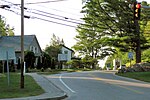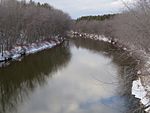Beebe River

The Beebe River is a 16.7-mile-long (26.9 km) river located in the White Mountains of New Hampshire in the United States. It is a tributary of the Pemigewasset River, part of the Merrimack River watershed. The Beebe River begins at Black Mountain Pond on the southern slopes of Sandwich Mountain, a 3,993-foot (1,217 m) summit in the southern White Mountains, in the town of Sandwich. The river drops off the mountain to the south, then turns west to travel through Sandwich Notch, staying in a wooded valley and entering the town of Campton. The valley broadens as the river approaches the village of Campton Hollow, where the river reaches New Hampshire Route 175 and drops over some small waterfalls. The river passes by the old industrial community of Beebe River and reaches the Pemigewasset River next to Interstate 93.
Excerpt from the Wikipedia article Beebe River (License: CC BY-SA 3.0, Authors, Images).Beebe River
Daniel Webster Highway,
Geographical coordinates (GPS) Address Nearby Places Show on map
Geographical coordinates (GPS)
| Latitude | Longitude |
|---|---|
| N 43.815833333333 ° | E -71.661111111111 ° |
Address
Daniel Webster Highway
Daniel Webster Highway
03223
New Hampshire, United States
Open on Google Maps
Experiences
Is this place worth visiting?
There's an old goldmine extending 80' into the bedrock right where the falls are, which splits in two directions inside - best to access when the river is at it's lowest and there are a few videos on YouTube showing people goin in......








